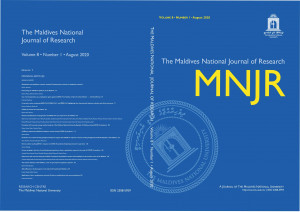Student Perceptions on Gender differences of ELT Teachers
DOI:
https://doi.org/10.62338/dweqmb84Keywords:
Perceptions, gender, language teachers, female, male, studentsAbstract
The effect of teacher gender on students of different gender is often shrugged off, as a lot of teachers themselves are not aware of gender biases and stereotyping in particular when these issues may not have been addressed effectively in their training programs, as not much research has been done on this particular aspect in recent years. Hence, it is an area that needs to be addressed in a more vigorous style particularly in the language learning arena, in order to explore and overcome any shortcomings that may exist with regard to gender differences. The purpose of this research is to identify the effects of teacher gender on students in terms of their perceptions as learners and thus cater to the following research question. Which teacher gender is preferred over the other by students among their language teachers and why? In order to do this, qualitative research design has been incorporated and data collected over a period of 2 months were analyzed and triangulated to accumulate the results which indicated that with regard to content delivery, female teachers topped off while male teachers flourished being spontaneous and more approachable in class. Furthermore, it was also found that both male and female students preferred male language teachers over female teachers due to the fact that they were perceived to be more “friendly” towards their students.
References
Aina, O. E., & Cameron, P. A. (2011). Why does gender matter? counteracting stereotypes with young children. Dimensions of Early Childhood, 39(3), 11-19.
Brown, A.F. (2007). Collaborative learning in the EAP classrooms. Gaborone: University of Botswana.
Brufee, A.K. (1986).Social Construction, Language, and the Authority of Knowledge: A Bibliographical Essay. Retrieved on 19th December 2014
From http://www.jstor.org/stable/376723?seq=1#page_scan_tab_contentsCentra, J.A., & Gaubatz,B.N.( 1999). Is there Gender bias in Student evaluation of teaching? retrieved on 19th December 2014 from https://www.ets.org/Media/Products/SIR_II/pdf/GenderBias.pdf
Chafi, E.M. & Elkhouzai,E. (2014). Classroom Interaction: Investigating the Forms and Functions of Teacher Questions in Moroccan Primary School, International Journal of Innovation and Applied Studies, vol. 6, no. 3, pp. 352–361, July 2014.
Chudgar , A & Sankar, V. (2008). The relationship between teacher gender and student achievement: evidence from five Indian states. Retrieved from 19th December 2014 from http://www.tandfonline.com/loi/ccom20
Coates, J.( 2003). Men talk: stories in the making of masculinities. Oxford: Blackwell.Dee. S. T. (2006). How a Teacher’s Gender Affects Boys and Girls. Pacific research institute; 22nd September 2014 from http://educationnext.org/the-why-chromosome/
Driessen, G. (2007). The feminization of primary education: Effects of teachers’ sex on pupil achievement, attitudes and behaviour. International Review of Education 53, no. 2: 183–203.
Grasha, A. (1994). Teaching with style: The integration of teaching and learning styles in the classroom. Essays on Teaching Excellence: Toward the Best in the Academy.Colorado State University: Professional and Organizational Development Network in Higher Education.
Hopf, R.D., & Hatzichristou.(1999). Teacher gender-related influences in GreekSchools. British Journal of Educational Psychology. 68, no1: 1-18
Jones, M. & Wheatley, J. (1990). Gender differences in teacher-student interactions in Science classrooms. Retrieved on 19th Dec.2014 from http://www.niu.edu/eteams/pdf_s/INTRODUCTION_SchmidtShumow/ ter.pdf
Khosravizadeh,P. & Pakzadian, S.S. (2010).The Relationship between EFL Teacher’s Gender and Student’s Willingness to Communicate. International Journal of Communication and Linguistic Studies 10, No 4:17-29
Krieg, J.M. (2005). Student gender and teacher gender: What is the impact on high stakes test Scores? Current issues in Education. 8, No 9:1-15
Krupnick, G.C. (1985). Women and Men in the Classroom:Inequality and Its Remedies Retrieved on 19th Dec.2014 from http://isites.harvard.edu/fs/html/icb.topic58474/krupnick.html
Madrid, D & Hughes, P. S. (2010). Speaking the Same Language? Gender-Based Teacher Performance in theEFL Class. The Open Applied Linguistics Journal, 3, 1-9
Martin,A & Marsh, H. (2005). Motivating boys and motivating girls: Does teacher gender really make a difference? Retrieved on 19th December from http://aed.sagepub.com/content/49/3/320.abstract
Maulana, R., Opdenakker, M-C., Brok, P., & Bosker, R. (2011). Teacher-student interpersonal relationships in Indonesian secondary education: Profiles and importance to student motivation. Asia Pacific Journal of Education 31(1), 33 – 49.
Michaelowa, K. 2001. Primary education quality in Francophone sub-Saharan Africa: Determinants of learning achievement and efficiency considerations. World Development 29, no. 10: 1699–716.
Slavin, E.R. (1995). Research on Cooperative Learning and Achievement: What We Know, What We Need to Know. Retrieved on 19th December 21, 2014 From http://socialfamily535.pbworks.com/f/slavin1996%5B1%5D.pdf
Sunderland, J. 1992. Gender in the ESL classroom. Oxford ELT Journal: Volume 46/1
Tan, E. K. & Sharbain, A.H.I. (2013). Gender differences in primary English language teachers’ attitudes towards the teaching profession: Woodpecker Journal of Educational Research ISSN 2315-7267 Vol. 2(5), pp. 071 – 077. UNESCO. 2000. Increasing the number of women teachers in rural schools: of country case studies: South Asia. Bangkok: UNESCO Principal Regional Office for Asia and the Pacific.
UNESCO. 2005. EFA global monitoring report 2005: The quality imperative. Paris UNESCO.2006. Advocacy brief: The impact of women teachers on girls’ education.Bangkok



